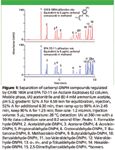Fast Separation of Dinitrophenylhydrazine Derivatives of Aldehydes and Ketones Determined by CARB Method 1004 and EPA Method TO-11
The Application Notebook
Carbonyl compounds, including low molecular weight aldehydes and ketones, have environmental and health concerns; for example, short-term exposure to aldehydes can irritate the eyes, skin, and upper respiratory tract. Motor vehicles emit reactive hydrocarbons that undergo photochemical oxidation in the atmosphere, which generates formaldehyde and other carbonyls. In addition, formaldehyde contributes to the formation of photochemical ozone. California Air Resources Board (CARB) Method 1004 (1) provides an analytical method for the automotive industry to monitor 13 carbonyl compounds in engine exhaust. US EPA Method TO-11A (2) and Method 8315 (3) monitor atmospheric formaldehyde and 14 other carbonyl compounds and are used for a variety of environmental and occupational health purposes. In these methods, carbonyl compounds are trapped as the dinitrophenylhydrazine (DNPH) derivatives before analysis by HPLC.
Carbonyl compounds, including low molecular weight aldehydes and ketones, have environmental and health concerns; for example, short-term exposure to aldehydes can irritate the eyes, skin, and upper respiratory tract. Motor vehicles emit reactive hydrocarbons that undergo photochemical oxidation in the atmosphere, which generates formaldehyde and other carbonyls. In addition, formaldehyde contributes to the formation of photochemical ozone. California Air Resources Board (CARB) Method 1004 (1) provides an analytical method for the automotive industry to monitor 13 carbonyl compounds in engine exhaust. US EPA Method TO-11A (2) and Method 8315 (3) monitor atmospheric formaldehyde and 14 other carbonyl compounds and are used for a variety of environmental and occupational health purposes. In these methods, carbonyl compounds are trapped as the dinitrophenylhydrazine (DNPH) derivatives before analysis by HPLC.
Traditional C18 columns used for this application tend to have poorly resolved peaks, even with coupling of two 250 mm columns. Recently, one commercial specialty column (4) improved on the C18 columns, but still could not provide complete resolution. The Dionex Acclaim® Explosives E2 stationary phase has a carefully tuned selectivity for nitroaromatic compounds which provide baseline separation for all 14 explosives compounds in US EPA Method 8330. This application demonstrates that the Acclaim E2 column also provides superior resolution for carbonyl DNPH derivatives within 10 min (Figure 1).
Experimental
Acclaim Explosives E2, 3 μm column (3.0 × 150 mm, dp = 3 μm, Cat. No. 070082, Dionex, Sunnyvale, CA) were used for the separation. Separations were performed on a modular UltiMate® 3000 HPLC System (Dionex) equipped with a LPG 3400 gradient pump, WPS-3000 Autosampler, TCC-3200 column oven, and a VWD-3400 detector. Chromeleon® 6.80 Chromatography Management Software (Dionex) was used for system control and data processing. Ready-made standard mixtures of DNPH derivatives were purchased from Sigma-Aldrich (St. Louis, MO) for CARB Method 1004 (Cat. No. 47651-U) and for EPA Method TO-11 (Cat. No. 47285-U).
Result and Discussion
The chromatographic method consists of an isocratic portion (6.30 min) followed by a gradient portion using acetonitrile/aqueous mobile phase system. While not strictly necessary, the use of an acetate buffer (4 mM) should improve the ruggedness of the method. As shown in Figure 1, using the same method, excellent separations were achieved on the Acclaim E2 column for carbonyl-DNPH compounds for the CARB Method 1004 and EPA Method TO-11 within 10 min. The typical cycle time for each analysis is 14 min 15 s. In addition, minor isomers of acetaldehyde-DNPH, propionaldehyde-DNPH, and butanone-DNPH can be separated from corresponding main peaks, which has not been demonstrated by any other columns.

Figure 1
Conclusion
Carbonyl compounds are important environmental pollutants. Acclaim E2 column offers a superior solution, in terms of resolution and throughput to analyzing these compounds regulated by CARB Method 1004 and EPA Method TO-11.
References
(1) http://www.arb.ca.gov/msprog/levprog/cleandoc/clean_nmogtps_final.pdf
(2) http://www.epa.gov/ttn/amtic/files/ambient/airtox/to-11ar.pdf
(3) http://www.epa.gov/waste/hazard/testmethods/sw846/pdfs/8315a.pdf
(4) http://www.restek.com/restek/images/external/59521B.pdf
Acclaim, Chromeleon, and UltiMate are registered trademarks of Dionex Corporation.
Dionex Corporation
1228 Titan Way, P.O. Box 3603, Sunnyvale, CA 94088-3603
tel. (408)737-0700, fax (408)730-9403
Website: www.dionex.com

Pick Your Poison. Isolation of Paclitaxel (Mar 2025)
March 7th 2025The diterpenoid, paclitaxel, which was identified as a potent chemotherapy agent for breast and ovarian cancer originates from the Pacific Yew tree. The isolation of paclitaxel from its major impurities is shown with the use of Hamilton’s PRP-1 (5 µm) HPLC column.















